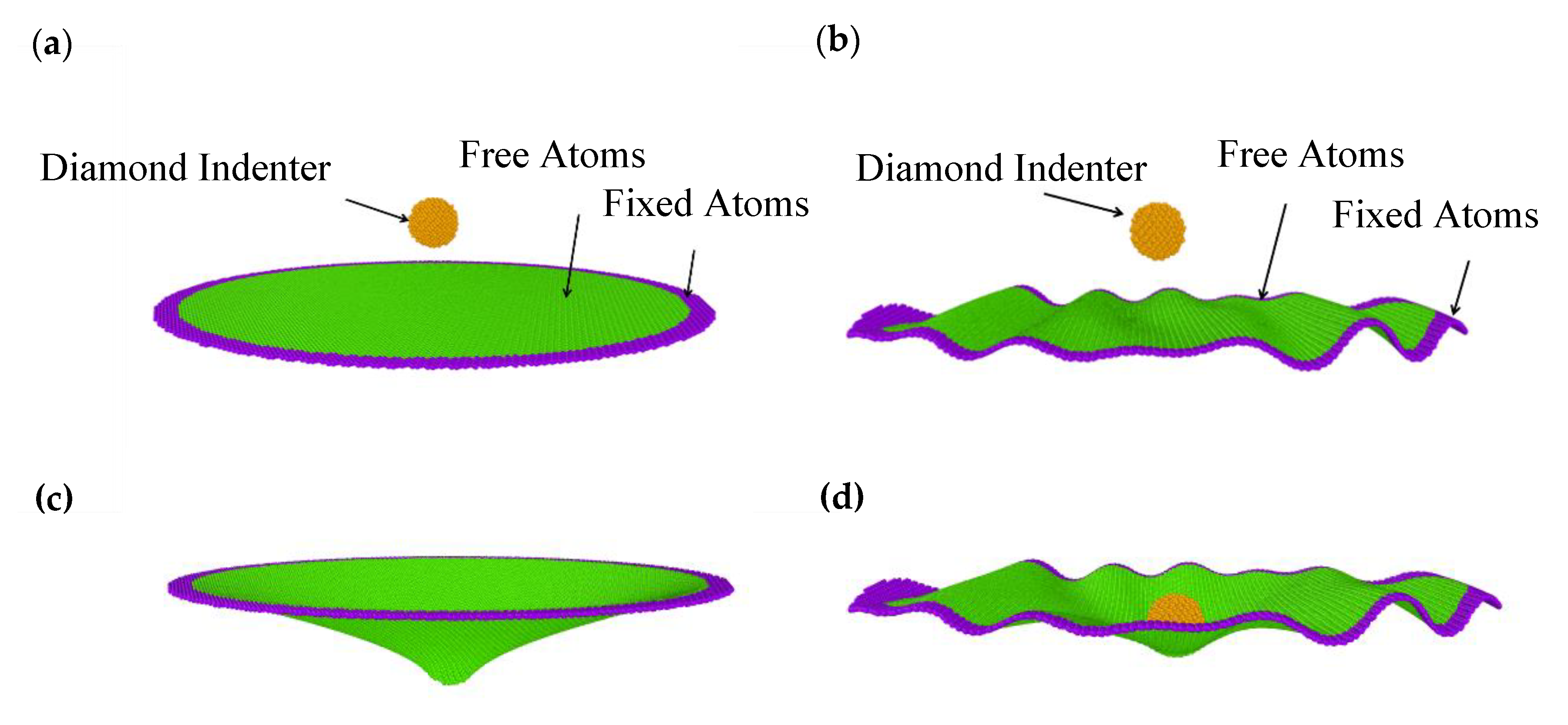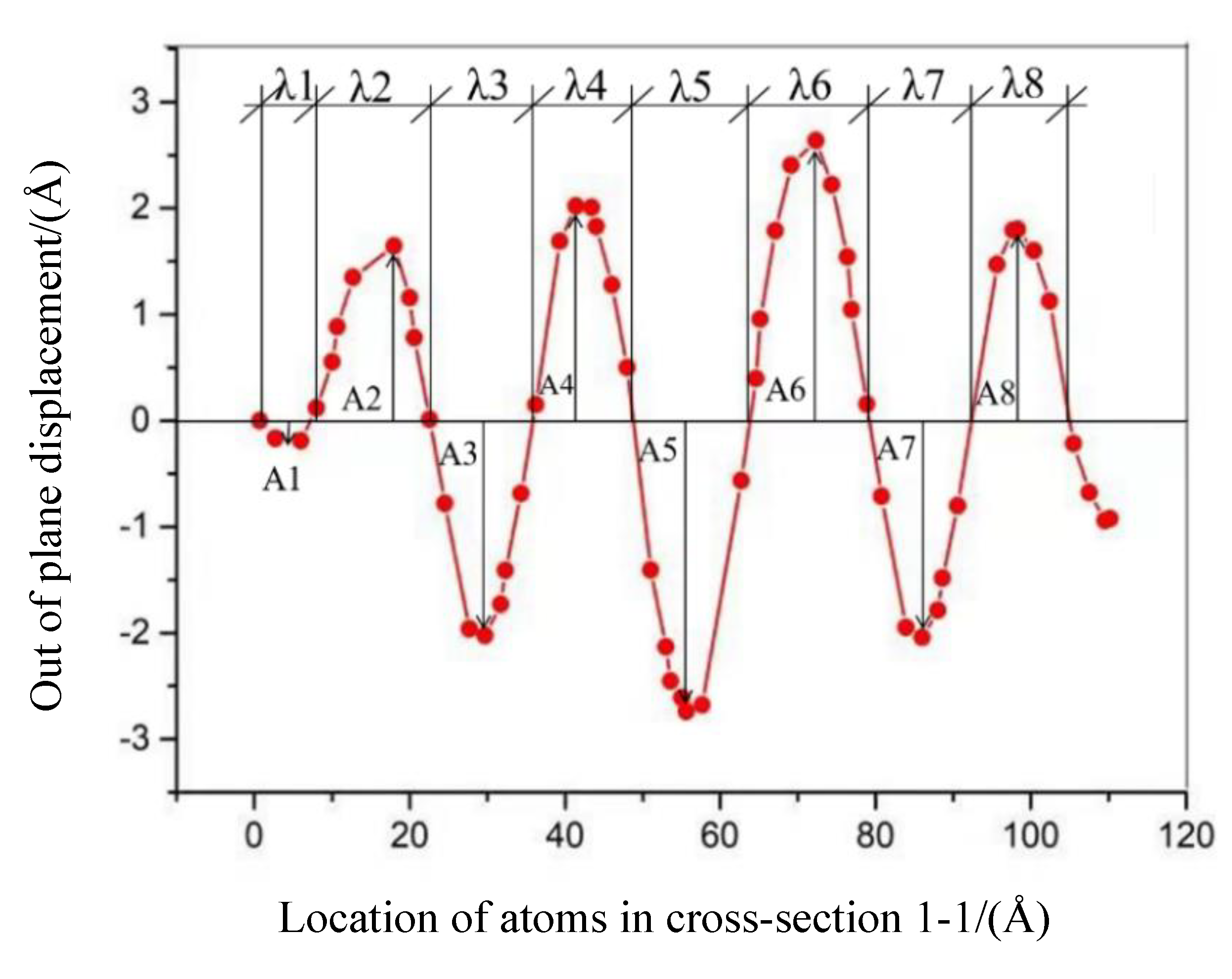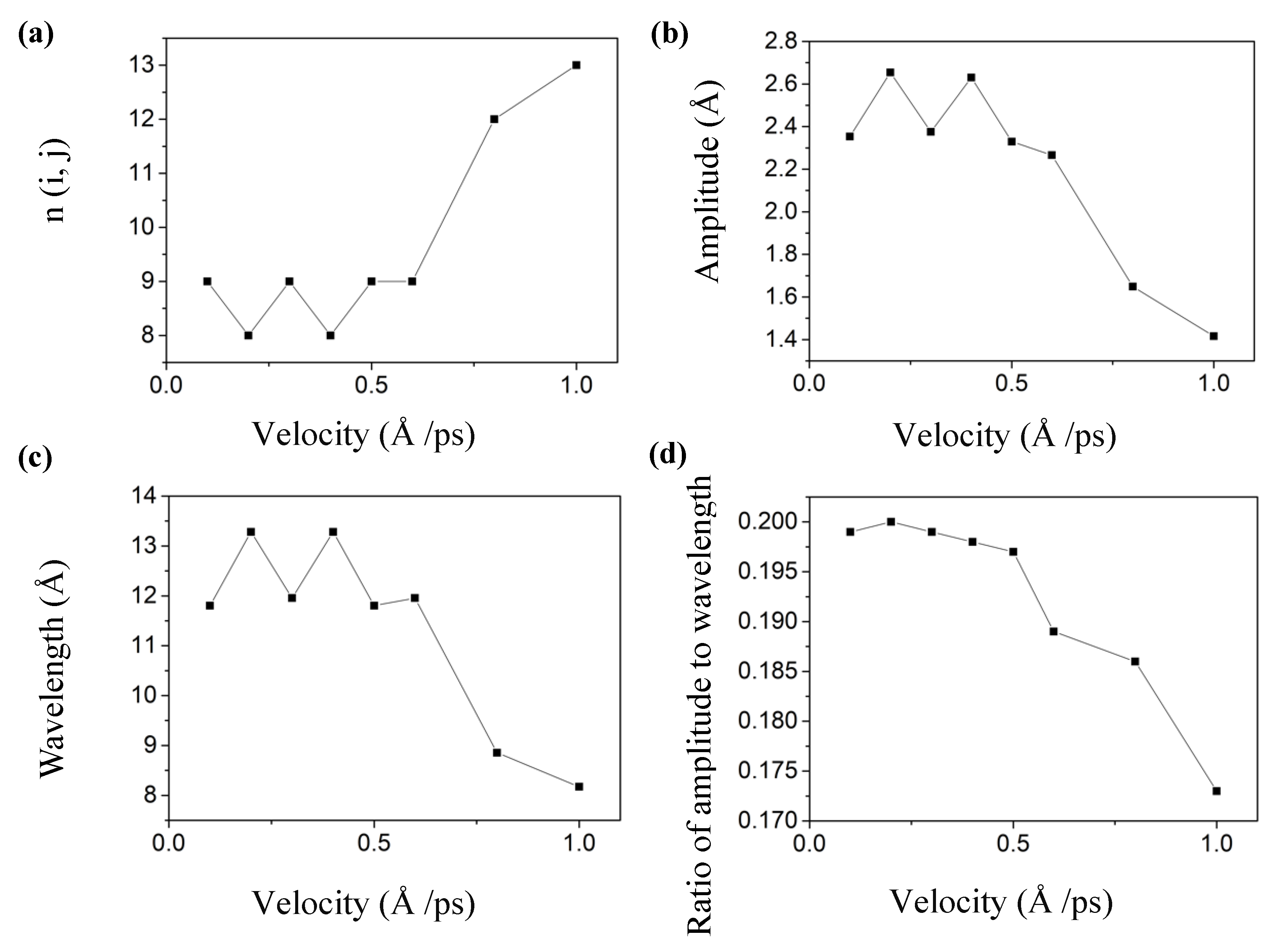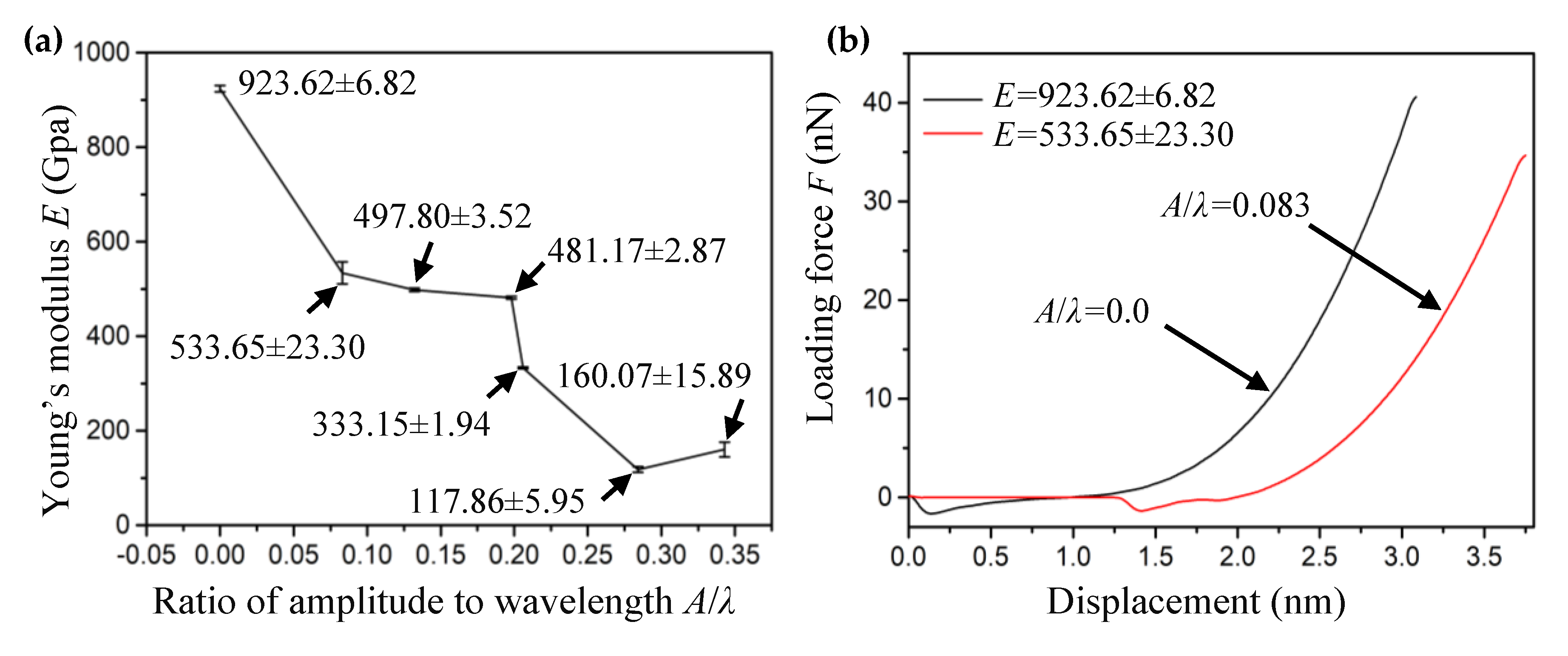Atomic Simulation of Nanoindentation on the Regular Wrinkled Graphene Sheet
Abstract
:1. Introduction
2. Theoretical Model and Methods
2.1. Wrinkle Model
2.2. Atomic Force Microscopy (AFM) Nanoindentation Model
3. Results and Discussions
3.1. Characterization of Wrinkles
3.2. Influence of Loading Velocity on Wrinkling Parameters
3.3. Wrinkle Formation under Different Boundary Conditions
3.4. Influence of Shear Displacement on Wrinkling Parameters
3.5. Effect of Wrinkles on Young’s modulus of Graphene during Nanoindentation
4. Conclusions
Supplementary Materials
Author Contributions
Funding
Acknowledgments
Conflicts of Interest
References
- Novoselov, K.S.; Geim, A.K.; Morozov, S.V.; Jiang, D.; Zhang, Y.; Dubonos, S.V.; Grigorieva, I.V.; Firsov, A.A. Electric field effect in atomically thin carbon films. Science 2004, 306, 666. [Google Scholar] [CrossRef] [PubMed] [Green Version]
- Schedin, F.; Geim, A.K.; Morozov, S.V.; Hill, E.W.; Blake, P.; Katsnelson, M.I.; Novoselov, K.S. Detection of individual gas molecules adsorbed on graphene. Nat. Mater. 2007, 6, 652–655. [Google Scholar] [CrossRef] [PubMed]
- Bunch, J.S.; van der Zande, A.M.; Verbridge, S.S.; Frank, I.W.; Tanenbaum, D.M.; Parpia, J.M.; Craighead, H.G.; McEuen, P.L. Electromechanical resonators from graphene sheets. Science 2007, 315, 490–493. [Google Scholar] [CrossRef] [PubMed] [Green Version]
- Bellucci, S.; Maffucci, A.; Maksimenko, S.; Micciulla, F.; Migliore, M.D.; Paddubskaya, A.; Pinchera, D.; Schettino, F. Electrical Permittivity and Conductivity of a Graphene Nanoplatelet Contact in the Microwave Range. Materials 2018, 11, 2519. [Google Scholar] [CrossRef] [Green Version]
- Novoselov, K.S.; Jiang, D.; Booth, T.; Khotkevich, V.V.; Morozov, S.M.; Geim, A.K. Two dimensional atomic crystals. Proc. Natl. Acad. Sci. 2005, 102, 10451–10453. [Google Scholar] [CrossRef] [Green Version]
- Zhang, L.; Shao, Y.; Tu, Z.; Liu, R.; Yang, F.; Jiang, D.; Guo, Y.; Ye, Z.; Liu, T.; Zhang, J. Graphene sensing an inhomogeneous strain due to the surface relief in FeNiCoTi shape memory alloy. J. Raman Spectrosc. 2014, 45, 1–6. [Google Scholar] [CrossRef]
- Kim, K.; Choi, J.Y.; Kim, T.; Cho, S.H.; Chung, H.J. A role for graphene in silicon-Based semiconductor devices. Nature 2011, 479, 338–344. [Google Scholar] [CrossRef]
- Zhang, T.; Xue, Q.; Zhang, S.; Dong, M. Theoretical approaches to graphene and graphene-Based materials. Nano Today 2012, 7, 180–200. [Google Scholar] [CrossRef]
- Liu, C.; Li, F.; Ma, L.P.; Cheng, H.M. Advanced materials for energy storage. Adv. Mater. 2010, 22, E28–E62. [Google Scholar] [CrossRef]
- Meyer, J.C.; Geim, A.K.; Katsnelson, M.I.; Novoselov, K.S.; Booth, T.J.; Roth, S.J.N. The structure of suspended graphene sheets. Nature 2007, 446, 60–63. [Google Scholar] [CrossRef]
- Bao, W.; Miao, F.; Chen, Z.; Zhang, H.; Jang, W.; Dames, C.; Lau, C.N. Controlled ripple texturing of suspended graphene and ultrathin graphite membranes. Nat. Nanotechnol. 2009, 4, 562–566. [Google Scholar] [CrossRef] [PubMed] [Green Version]
- Guo, Y.; Guo, W. Electronic and field emission properties of wrinkled graphene. J. Phys. Chem. C 2013, 117, 692–696. [Google Scholar] [CrossRef]
- Ruiz-Vargas, C.S.; Zhuang, H.L.; Huang, P.Y.; van der Zande, A.M.; Garg, S.; McEuen, P.L.; Muller, D.A.; Hennig, R.G.; Park, J. Softened elastic response and unzipping in chemical vapor deposition graphene membranes. Nano Lett. 2011, 11, 2259–2263. [Google Scholar] [CrossRef] [PubMed]
- Lin, Q.Y.; Jing, G.; Zhou, Y.B.; Wang, Y.F.; Meng, J.; Bie, Y.Q.; Yu, D.P.; Liao, Z.M. Stretch-Induced stiffness enhancement of graphene grown by chemical vapor deposition. ACS Nano 2013, 7, 1171–1177. [Google Scholar] [CrossRef]
- López-Polín, G.; Jaafar, M.; Guinea, F.; Roldán, R.; Gómez-Navarro, C.; Gómez-Herreroae, J. The influence of strain on the elastic constants of graphene. Carbon 2017, 124, 42–48. [Google Scholar] [CrossRef] [Green Version]
- Huang, J.; Han, Q. A molecular dynamics study on wrinkles in graphene with simply supported boundary under in-Plane shear. J. Nanomater. 2017, 2017, 1326790. [Google Scholar] [CrossRef]
- Wang, C.Y.; Mylvaganam, K.; Zhang, L.C. Wrinkling of monolayer graphene: A study by molecular dynamics and continuum plate theory. Phys. Rev. B 2009, 80, 155445. [Google Scholar] [CrossRef] [Green Version]
- Gil, A.J.; Adhikari, S.; Scarpa, F.; Bonet, J. The formation of wrinkles in single-Layer graphene sheets under nanoindentation. J. Phys. Condens. Mat. 2010, 22, 145302. [Google Scholar] [CrossRef] [PubMed]
- Min, K.; Aluru, N.R. Mechanical properties of graphene under shear deformation. Appl. Phys. Lett. 2011, 98, 013113. [Google Scholar] [CrossRef] [Green Version]
- Zhang, Z.; Duan, W.H.; Wang, C.M. Tunable wrinkling pattern in annular graphene under circular shearing at inner edge. Nanoscale 2012, 4, 5077. [Google Scholar] [CrossRef]
- Wang, C.; Liu, Y.; Lan, L.; Tan, H. Graphene wrinkling: Formation, evolution and collapse. Nanoscale 2013, 5, 4454–4461. [Google Scholar] [CrossRef] [PubMed]
- Baimova, J.A.; Dmitriev, S.V.; Zhou, K.; Savin, A.V. Unidirectional ripples in strained graphene nanoribbons with clamped edges at zero and finite temperatures. Phys. Rev. B 2012, 86, 035427. [Google Scholar] [CrossRef]
- Zhao, J.; Guo, X.; Lu, L. Small-Size effect on wrinkle and fracture of monolayer graphene subjected to in-Plane shear. Nanotechnology 2017, 28, 455702. [Google Scholar] [CrossRef] [PubMed] [Green Version]
- Wang, W.; Li, S.; Min, J.; Yi, C.; Zhan, Y.; Li, M. Nanoindentation experiments for single-Layer rectangular graphene films: A molecular dynamics study. Nanoscale Res. Lett. 2014, 9, 41. [Google Scholar] [CrossRef] [PubMed] [Green Version]
- Park, Y.; Hyun, S. Size effect of defects on the mechanical properties of graphene. J. Korean Phys. Soc. 2018, 72, 681–686. [Google Scholar] [CrossRef]
- Wang, W.; Li, L.; Yang, C.; Soler-Crespo, R.; Meng, Z.; Li, M.; Zhang, X.; Keten, S.; Espinosa, H. Plasticity resulted from phase transformation for monolayer molybdenum disulfide film during nanoindentation simulations. Nanotechnology 2017, 28, 164005. [Google Scholar] [CrossRef]
- Pang, H.; Li, M.; Gao, C.; Huang, H.; Zhuo, W.; Hu, J.; Wan, Y.; Luo, J.; Wang, W. Phase transition of single-Layer molybdenum disulfide nanosheets under mechanical loading based on molecular dynamics simulations. Materials 2018, 11, 502. [Google Scholar] [CrossRef] [Green Version]
- Plimpton, S. Fast parallel algorithms for short-range molecular dynamics. J. Comput. Phys. 1995, 117, 1–19. [Google Scholar] [CrossRef] [Green Version]
- Stukowski, A. Visualization and analysis of atomistic simulation data with OVITO–The Open Visualization Tool. Model. Simul. Mater. Sci. 2010, 18, 2154–2162. [Google Scholar] [CrossRef]
- Tan, X.; Wu, J.; Zhang, K.; Peng, X.; Sun, L.; Zhong, J. Nanoindentation models and Young′s modulus of monolayer graphene: A molecular dynamics study. Appl. Phys. Lett. 2013, 102, 071908. [Google Scholar] [CrossRef]
- Scott, O.N.; Begley, M.R.; Komaragiri, U.; Mackin, T.J. Indentation of freestanding circular elastomer films using spherical indenters. Acta Mater. 2004, 52, 4877–4885. [Google Scholar] [CrossRef]
- Lee, C.; Wei, X.; Kysar, J.W.; Hone, J. Measurement of the elastic properties and intrinsic strength of monolayer graphene. Science 2008, 321, 385–388. [Google Scholar] [CrossRef] [PubMed]
- Xiang, L.; Ma, S.Y.; Wang, F.; Zhang, K. Nanoindentation models and Young’s modulus of few-Layer graphene: A molecular dynamics simulation study. J. Phys. D Appl. Phys. 2015, 48, 395305. [Google Scholar] [CrossRef]
- Huang, J.; Han, Q. Study on wrinkling in graphene under gradient shear by molecular dynamics simulation. J. Mol. Model. 2015, 21, 31. [Google Scholar] [CrossRef] [PubMed]
- Lee, C.; Wei, X.; Li, Q.; Carpick, R.; Kysar, J.W.; Hone, J. Elastic and frictional properties of graphene. Phys. Status Solidi B 2009, 246, 2562–2567. [Google Scholar] [CrossRef]
- Duan, W.; Gong, K.; Wang, Q. Controlling the formation of wrinkles in a single layer graphene sheet subjected to in-Plane shear. Carbon 2011, 49, 3107–3112. [Google Scholar] [CrossRef]







| Boundary Conditions | Top Boundary | Bottom Boundary |
|---|---|---|
| BC1 | Ux is free, and other DOFs are fixed | all DOFs are fixed |
| BC2 | all DOFs are free | Uz is free, and other DOFs are fixed |
| BC3 | all DOFs are free | Uy is fixed, and other DOFs are free |
| BC4 | all DOFs are free | all DOFs are free |
| BC5 | all DOFs are free | all DOFs are free |
© 2020 by the authors. Licensee MDPI, Basel, Switzerland. This article is an open access article distributed under the terms and conditions of the Creative Commons Attribution (CC BY) license (http://creativecommons.org/licenses/by/4.0/).
Share and Cite
Wang, R.; Pang, H.; Li, M.; Lai, L. Atomic Simulation of Nanoindentation on the Regular Wrinkled Graphene Sheet. Materials 2020, 13, 1127. https://doi.org/10.3390/ma13051127
Wang R, Pang H, Li M, Lai L. Atomic Simulation of Nanoindentation on the Regular Wrinkled Graphene Sheet. Materials. 2020; 13(5):1127. https://doi.org/10.3390/ma13051127
Chicago/Turabian StyleWang, Ruonan, Haosheng Pang, Minglin Li, and Lianfeng Lai. 2020. "Atomic Simulation of Nanoindentation on the Regular Wrinkled Graphene Sheet" Materials 13, no. 5: 1127. https://doi.org/10.3390/ma13051127
APA StyleWang, R., Pang, H., Li, M., & Lai, L. (2020). Atomic Simulation of Nanoindentation on the Regular Wrinkled Graphene Sheet. Materials, 13(5), 1127. https://doi.org/10.3390/ma13051127





